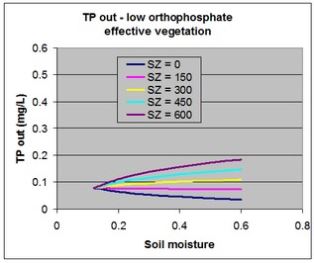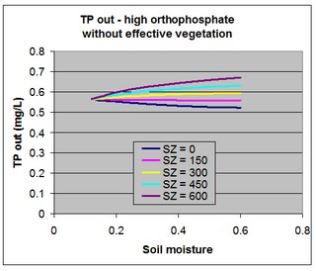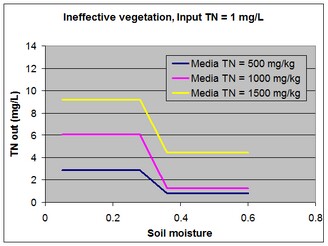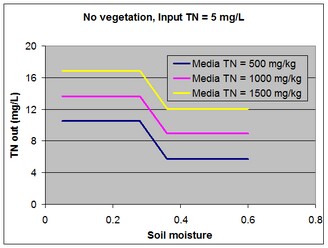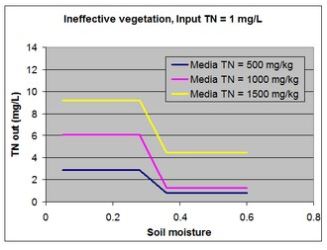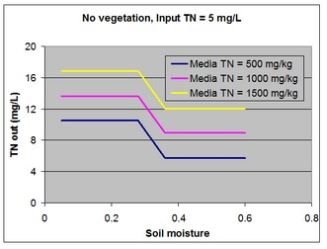MUSIC v5 Bioretention Updates
Water quality treatment in bioretention systems has been revised for use in music v5. More emphasis is placed on the continuity of explanatory variables which are in principle continuous, and the analysis is based on a multiple regression approach. Additional data has been brought in from the original data files of the three column studies where appropriate under the new methodology.
Total Suspended Solids
Modelled outflow TSS concentration depends on the soil moisture at the start of the event (continuous variable) and the vegetation type (categorical variable), as shown below.
In spreadsheet terminology the modelled outflow TSS concentration from effectively vegetated filters is: 1.27 - 1.96 * LN(MAX(SoilMoisture, 0.09))
where SoilMoisture is a dimensionless fraction between 0 and 1 and outflow TSS concentration is in mg/L.
- The modelled outflow TSS concentration follows the natural log function of soil moisture shown, in which the soil moisture is truncated at a lower limit of 0.09.
- The modelled outflow TSS concentration from ineffectively vegetated filters uses the same relationship as for effectively vegetated filters above.
- The modelled outflow TSS concentration from unvegetated filters is: MIN(MAX(37.9 - 95.0 * SoilMoisture, 2), 12)
- The outflow TSS concentration follows the linear function shown, but the outflow concentration must not be less than 2 or greater than 12.
- The previous TSS treatment calculations used the proportion of organic material in filter, which was entered by the user in the bioretention properties dialog box. This is no longer required, so the question could now be removed from the dialog box.
Total Phosphorus
Outflow TP concentration depends on the orthophosphate content of the filter medium, the depth of a submerged zone (if present), the filter soil moisture content at the start of the event (all continuous variables), and the vegetation type (categorical variable).
In spreadsheet terminology the modelled outflow TP concentration from effectively vegetated filters is: MAX(0.00028 * SubZoneDepth + 0.0043 * FilterOrtho + (-0.027 * LN(MAX(SoilMoisture, 0.12)) - 0.008) * (174 - SubZoneDepth) / 174 - 0.12, 0.02)
where SoilMoisture is a dimensionless fraction between 0 and 1, SubZoneDepth is the depth of the submerged zone in millimetres, FilterOrtho is the orthophosphate content of the filter medium in mg/kg, and outflow TP concentration is in mg/L.
- The modelled outflow TP concentration is the sum of the three terms shown (and a constant), but not less than 0.02. The first two terms are contributions due to submerged zone depth and filter orthophosphate. The third term is a natural log function of soil moisture times a function of submerged zone depth in which the soil moisture is truncated at a lower limit of 0.12.
- The modelled outflow TP concentration from ineffectively vegetated filters is: MAX(0.00028 * SubZoneDepth + 0.0043 * FilterOrtho + (-0.027 * LN(MAX(SoilMoisture, 0.12)) - 0.008) * (174 - SubZoneDepth) / 174 + 0.12, 0.02)
- The only difference between these two cases, as it happens, is the sign of the constant.
- The modelled outflow TP concentration from unvegetated filters uses the same relationship as for ineffectively vegetated filters immediately above. Note that the three vegetation types are grouped differently for TSS and TP.
Here are some sample modelled outflow TP concentrations.
Total Nitrogen
Outflow TN concentration depends on the total nitrogen content of the filter medium, the total nitrogen concentration of the inflow, the filter soil moisture content at the start of the event (all continuous variables), and the vegetation type (categorical variable).
In spreadsheet terminology the modelled outflow TN concentration from effectively vegetated filters is: MAX(0.74 * InflowTN + 0.0016 * FilterTN - 1.77 * LN(MAX(SoilMoisture, 0.09)) - 3.94, 0.3)
where SoilMoisture is a dimensionless fraction between 0 and 1, InflowTN is the total nitrogen concentration of the inflow in mg/L, FilterTN is the total nitrogen content of the filter medium in mg/kg, and outflow TN concentration is in mg/L.
- The modelled outflow TN concentration is the sum of the three terms shown (and a constant), but not less than 0.3. The first two terms are contributions due to inflow concentration and filter composition. The third term is a natural log function of soil moisture in which the soil moisture is truncated at a lower limit of 0.09.
- The modelled outflow TN concentration from ineffectively vegetated filters is: MAX(0.596 * InflowTN + 0.0063 * FilterTN - 59.7 * MIN(MAX(SoilMoisture, 0.28), 0.36) + 15.86, 0.8)
- The modelled outflow TN concentration is the sum of the three terms shown (and a constant), but not less than 0.8. The first two terms are contributions due to inflow concentration and filter composition. The third term is a function of soil moisture in which the soil moisture is truncated at a lower limit of 0.28 and an upper limit of 0.36.
- The modelled outflow TN concentration from unvegetated filters is: MAX(0.596 * InflowTN + 0.0063 * FilterTN - 59.7 * MIN(MAX(SoilMoisture, 0.28), 0.36) + 21.1, 0.8)
The only difference between these last two cases is the magnitude of the constant.
Here are some sample modelled outflow TN concentrations.

